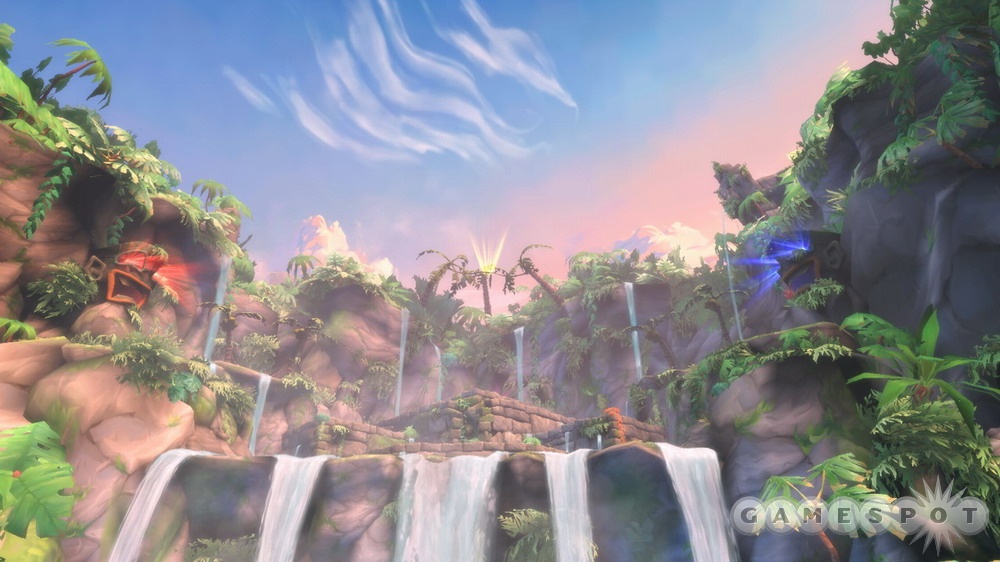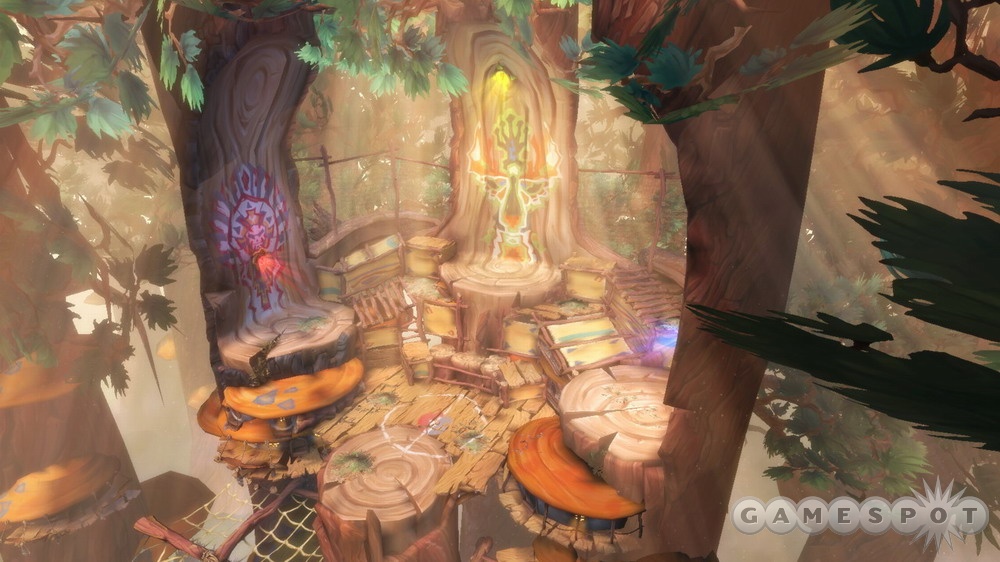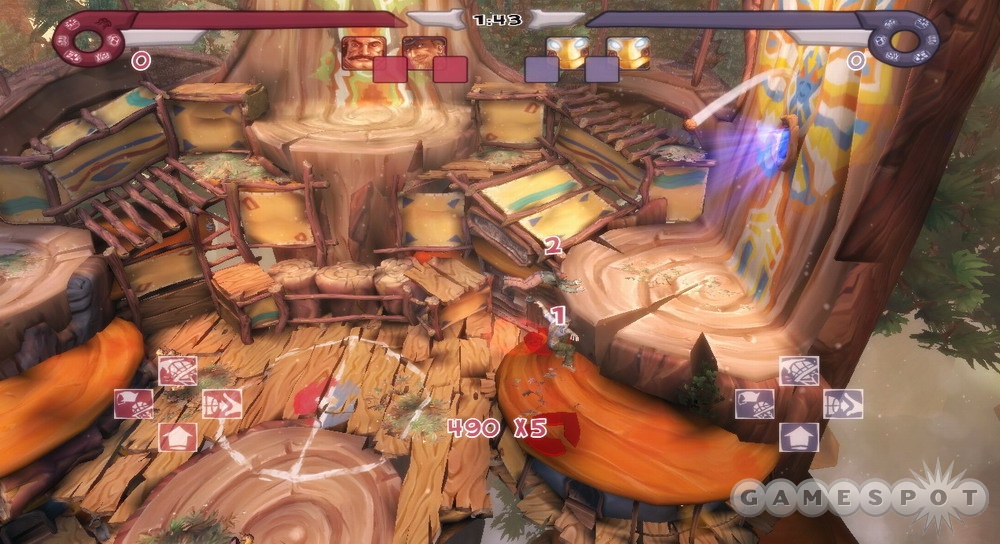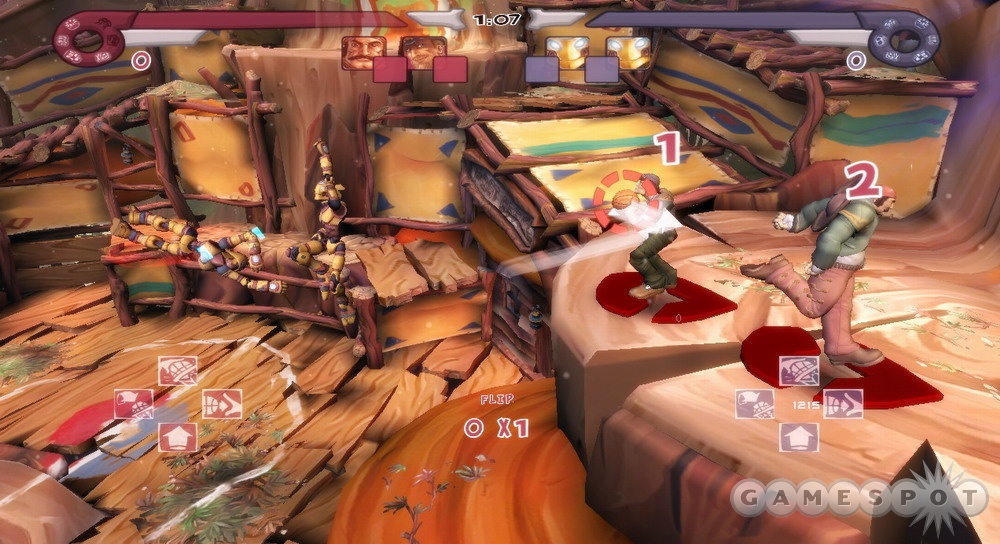HoopWorld Designer Diary #1 -- Get Some Rest, Bezzy
Fueled on coffee and cola, Aubrey Hesselgren takes a break to fill us in on the progress of this Xbox Live Arcade basketball game.
The upcoming Xbox Live Arcade basketball game HoopWorld is nothing if not unique. It's a sports game that isn't exactly a sports game; it's an arcade basketball game that is attempting to bridge a number of disparate genres within its gameplay; and it's powered by the Unreal engine, which is usually reserved for the likes of first-person shooters. In the four years since the game's original conception, HoopWorld has undergone a number of different changes, and bringing those disparate ideas to fruition has been a labor of love for Streamline Studio's Aubrey Hesselgren. In our first HoopWorld designer diary, Hesselgren talks about the game's evolution, its various influences, and the process of bringing the development studio's game to the Xbox Live Arcade service.
Get Some Rest, Bezzy
By Aubrey HesselgrenLead Designer, Streamline Studios
I'm not sure how this happened, but I'm a lead designer on a next-generation game. I really should be resting for the final month of crunch we have ahead. But I just can't seem to sleep. Every thought I have seems to cascade back toward this mad game: HoopWorld.

When I joined Streamline Studios, my original brief was to design an easy-to-play, over-the-top rendering of basketball, based on our Chief Creative Officer, Hector Fernandez's, original concept. It didn't have to be the exact same game. In fact, Hector encouraged me to take the game and "make it your own." Being given a roughly blank canvas is one of the reasons I wanted to join Streamline, even though, at the time, it was composed of only eight people. Things have changed, and now Streamline has grown to around 50 people, working on some major outsourcing projects, as well as this, our first game. The people here are people like me--willing to take a chance to prove themselves in the games industry.
Hector left me to it. I thought about the ways that basketball interested me, and came up with a few things: the spectacular dribbling and dunking, the skillful positioning and team work. But I also came away with a lot of questions: Why are basketball's rules so restrictive? Why can't you double dribble? Why can't you travel with the ball? Why can't you block the net? Why can't you punch people in the face?
There are obvious answers to all these questions, but the root of the cause was that basketball, as a sport, is grounded in reality. These restrictions don't make basketball bad, because we when we play, we accept that we play on top of reality's laws. We can never step outside of them. But a video game can be an abstraction of reality. At most, we use reality as metaphor; we can explain the game using real-world references, and give the game mechanics some kind of systemic, social, and emotional grounding in the existing preconceptions of the player. The big question was, why should we condemn ourselves to the same rules as basketball, when HoopWorld is not implicitly subject to the laws of physics? With this in mind, HoopWorld's gameplay was born out of abstraction. Perhaps it's only fitting that we are using the "Unreal" engine.
The team may be based in notoriously free-spirited Amsterdam, but HoopWorld's design was pieced together using nothing stronger than cola and coffee. I'm guessing that those two evils combined are part of what is keeping me awake right now. But I've another nagging thought, caught somewhere between the two halves of my brain.
"What is HoopWorld?" I ask myself this now, and every other day during development, and the answer is never quite the same. The game has always been hard for me to describe. It's part beat-'em-up, part free running, and part basketball (Basketbrawl? Freestyle?). And it is still basketball, technically speaking. There are baskets, and there are balls. That's the basics covered, right? Right? Unfortunately, very few of the people who have witnessed the game have ever accused it of being "like basketball."

A lot of folks were kind of surprised to find out that this was the Unreal 2.x engine--it's not typical for a sports game to come out of a first-person shooter-focused engine, let alone on Live Arcade, let alone a sports game that isn't really a sports game. Some people have also just assumed that we've been making HoopWorld with Unreal 3 technology, which I guess the artists and coders here at Streamline Studios can take as a great compliment. While the two engines come from the same Epic stable, they're rather different under the hood. 2.x was made with the Xbox in mind, and so it's optimized for that. Unreal 3, of course, is made for next-generation platforms. That means we've spent a lot of time taking the optimizations for the Xbox, and moving it over to the Xbox 360--trying to catch up with Unreal 3, in a sense.
Thinking back, HoopWorld has changed a great deal since the first prototype, a good four years ago. It moved from a realistic urban basketball court game into a second prototype: a Looney Tunes-inspired basketball game, set on the craggy rocks of the Grand Canyon. Even then, it was considered "over the top." The second version was the first I ever saw, and was the catalyst for the game we've ultimately made: arcade multiplayer basketball that has almost entirely forgotten its own rules.

While designing the newest version, Hector and Alex had been showing the prototypes around, gaining lots of interest from different parties. Microsoft extended an offer to put HoopWorld onto Xbox 360 live. At first we were skeptical--a 50MB limit might hold the game back from reaching where we wanted it to be. At the same time, the game was so out there, and the company was so new, that this was our best chance to get the game out to the people. Let me say this in bold: God bless Live Arcade. Without it, the chances of launching such an absurd game would be incredibly slim.
Designing a game for Live Arcade is not much different from designing for any other platform. Ultimately there are going to be unique strengths, weaknesses, and limitations for each platform, but those considerations rarely affect the core design in critical ways. From the start, HoopWorld was designed for a standard console joypad, so there were very few control changes to be made in moving the design over to the 360. Microsoft has created a lot of common tools for developers to use--they've taken the legwork out of things like leaderboards. The other interesting aspect has been the "standardization": Award systems are similar in all the X360 games, and menus share common layouts. These considerations give gamers an easier time getting into a game--learn one layout, and you've learned them all. Early on, I was worried that standardization might become homogenization and start to impinge on core gameplay. Credit should go to Microsoft's Live team, because this never happened.
I find myself occasionally worrying about how far HoopWorld has deviated from literal-minded sports games like NBA Jam or Pro Evolution Soccer. In the office we'll talk about how real basketball matches are played so that we can make the artificial intelligence more interesting and more believable. It helps to an extent, but because HoopWorld's core rules encourage over-the-top behavior, we know that we have to take that sort of discussion with a grain of salt. In a sport so new, who can say what the "right" way to play is? Today, our AI does not play as a professional basketball player might, because they're not playing basketball; they're playing HoopWorld.
That idea is reinforced during conversations with any of the 25-strong members who have come on board over the last nine months. "HoopWorld is just...something else. Yeah, it's a bit scary, but the alternative is working on a clone of some other game." There's understandable apprehension. What are our references? What is the game most like? Should we try to be more like this game or that game, or should we revel in our differences and find our own voice? When you can only take cursory inspiration from real sports, what other references can you turn to?
When asked about this, people are a little surprised when I mention turn-based games like Phantom Brave and puzzle games like Panel de Pon alongside obvious analogies like Street Fighter 2 and SpeedBall 2. It takes a while, but in HoopWorld, there's a depth that slowly exposes itself as you get used to the core controls. That comes from looking at HoopWorld's design as an old-style board game, with simple but expressive and interesting choices at every turn. It's deep enough to be cerebral, but you just happen to play at a very, very high speed.
So, at first, you might be happy to just slide under the enemy attacks and simply dunk the ball. By conventional standards, that's already pretty slick; but in HoopWorld, it's considered basic compared to what's possible. It's when you combine the various moves with your teammates that the game really comes alive. Trailblazing a red-hot shot at your enemy, running up a wall, and then alley-ooping the ball into the net as it bounces off your foe's face and back to you is a personal favorite, but it only begins to expose the range of possible combinations.
I guess that's one thing that puts a bit of confidence in me. No matter what stage we've been at during the game's development, I (personally) have always had fun, even with the simple aspects, like running around walls and jumping off straight into a dunk. As we find and fix more bugs, the experience only becomes more refined.

Not too long ago, we brought in testers for the first time. I was so nervous. It was an early version, with lots of bugs and incomplete gameplay. (At that point, you weren't even able to shoot at a basket). We gave everyone the chance to leave their politeness at the door, and totally lay into the game if they wanted to. They certainly did, identifying real areas for improvement. At the same time it was a relief to see that the majority were able to see past its unfinished state, to what the game was trying to be. And they seemed to like what they saw.
Seeing that this is our first commercial game (we've partnered with many companies and have contributed to several games) we're all a bit nervous and eager to see how the world takes to HoopWorld. Even so, everyone on the project is eager to give their best shot.
With that in mind, I can chill out a bit. It's time for me to go to bed without the fear of more nightmares. Instead, I'll dream of 100-foot alley-oops and humanly impossible basketball combinations, knowing that soon, that dream will be a reality. Good night!
Got a news tip or want to contact us directly? Email news@gamespot.com
Join the conversation